VOLUNTEERS CORNER ❘ By TOM GARRITY
Hopefully, the COVID-19 pandemic is over but, unfortunately, public health organizations around the globe still warn us that we may be dealing with seasonal outbreaks or new variants of the Omicron variant for years. According to Dr. Chris Murray, director and lead modeler for the Institute for Health Metrics and Evaluation, an independent global health research center at the University of Washington, we should expect an increase of infections this winter. As winter is here, the lessons learned during the 2020-2021 COVID-19 pandemic can help the fire service prepare to safely train firefighters during future outbreaks.
- Are You ‘Only’ a Volunteer Firefighter?
- Firefighter Training Paradigm Shift from COVID-19: Traditional vs. Online Learning
- A Solution to Volunteer Recruitment and Retention: Training
- Three Options for Training Rookie Volunteer Members
Developing the Training Plan
On March 12, 2020, the unexpected occurred. Training at the Montgomery County (PA) Fire Academy ended because of the rapidly spreading pandemic. Several classes were stopped midstream, and fire academy and police training staff co-located on the Montgomery County Department of Public Safety training campus with emergency medical services staff were deployed to oversee the first Montgomery County COVID-19 testing site on the Temple University—Ambler campus.
We returned to the academy in April 2020 and began work on a plan to resume training. All county facilities were closed to the public. To restart training, we had to develop a safety plan we could submit to the county as well as the Pennsylvania State Fire Academy for approval. Fortunately, the Montgomery County Department of Public Safety implemented the Office of the Medical Director. With the assistance of Dr. Alvin Wang, DO, and Dr. Brian Pasquale, Ph.D., we completed and received approval for the plan from the county and state fire academy. The plan included reduced classroom capacity, social distancing, masks for students and instructors, temperature scans (including second scans before lunch on the weekends), and COVID-19 symptom screenings as students entered.
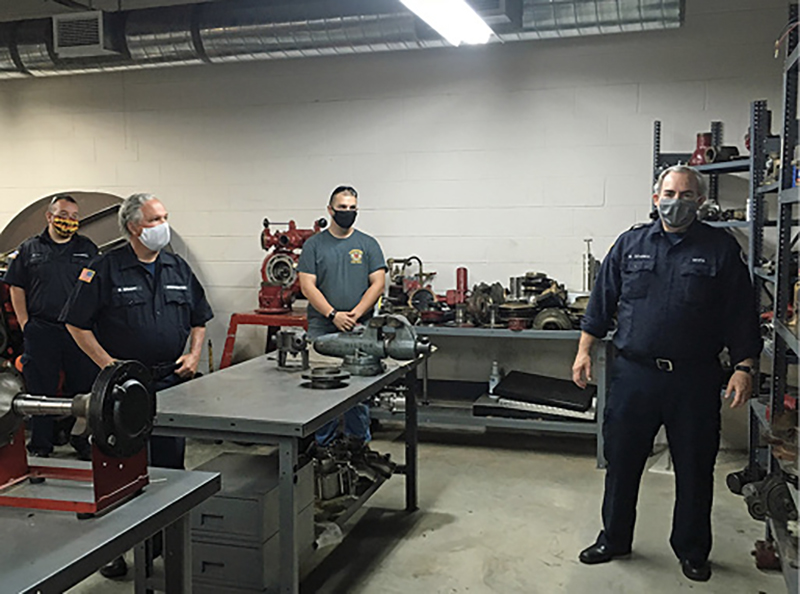
(1) Instructor Robert Sparks (right) with students in the Pump I class. (Photos by author.)

(2) Instructor Ray Fegley taking roll call after lunch during the Interior Firefighter class in the outdoor classroom.
Our facilities staff installed hand sanitizing stations throughout the building, and we sanitized classroom desks and cafeteria tables with an operating room sanitizing spray before each use. We also used a fogger to sterilize rooms if someone reported he had tested positive. Our plan and the equipment we would use required additional training and staffing on evenings and weekends.
We also constructed an outdoor classroom in the drill tower to increase training capacity. However, we quickly realized that, to reach the number of students who needed or wanted training with reduced indoor classroom capacities, we needed the ability to deliver training synchronously online. To do this, we would need a learning management system that included a Web conferencing platform. Our IT staff at Eagleville helped us obtain licenses for two major online video platforms. Fortunately, the program coordinators had experience with online training, and we had master course documents for all courses. However, to ensure consistency with our online courses, we all attended an online professional development course for online learning and implemented online course design standards. Many of our instructors were involved with online conferences in their full-time careers, so it was just a matter of refining and standardizing our online courses to ensure the synchronous online classes met the same standards as our in-person courses.
Course Launch
In May 2020, we offered “Introduction to the Fire Service” as our first online hybrid course. In June, we restarted training with the goal of finishing the courses cut short because of the pandemic. In September, we began the fall semester with all the public health protective measures in place and with additional courses offered synchronously online.
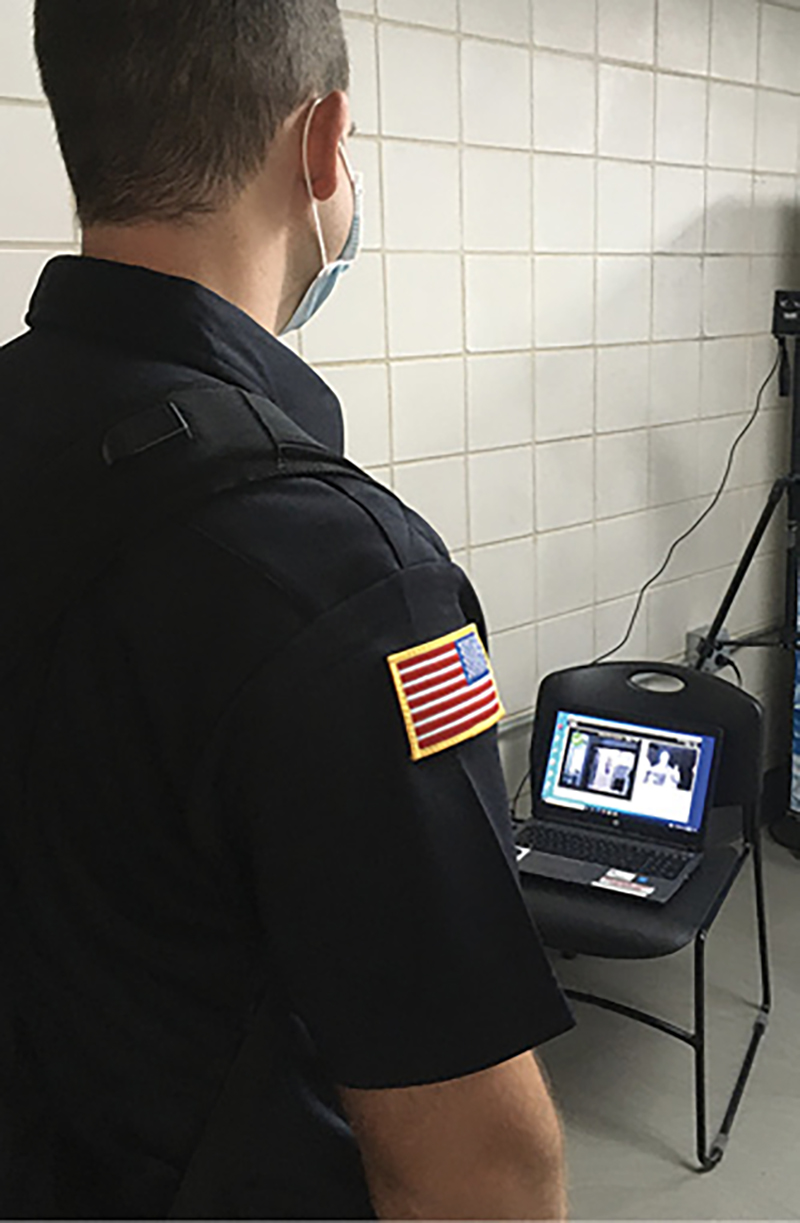
(3) A student waits for the results of a temperature scan prior to lunch.
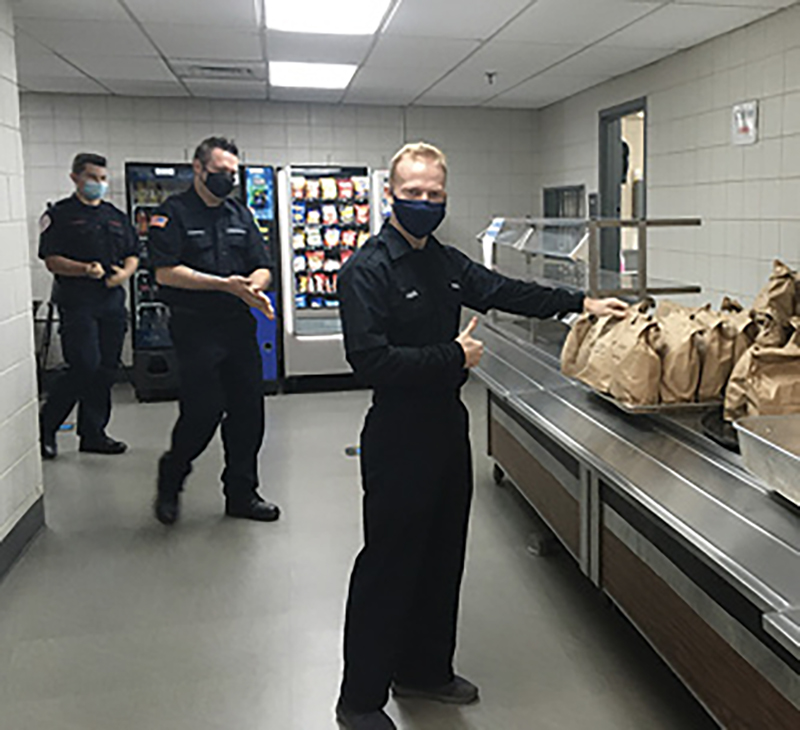
(4) After their temperature scans, students attending weekend training at the Montgomery County Fire Academy stand in line, six feet apart, to pick up their bagged lunches.
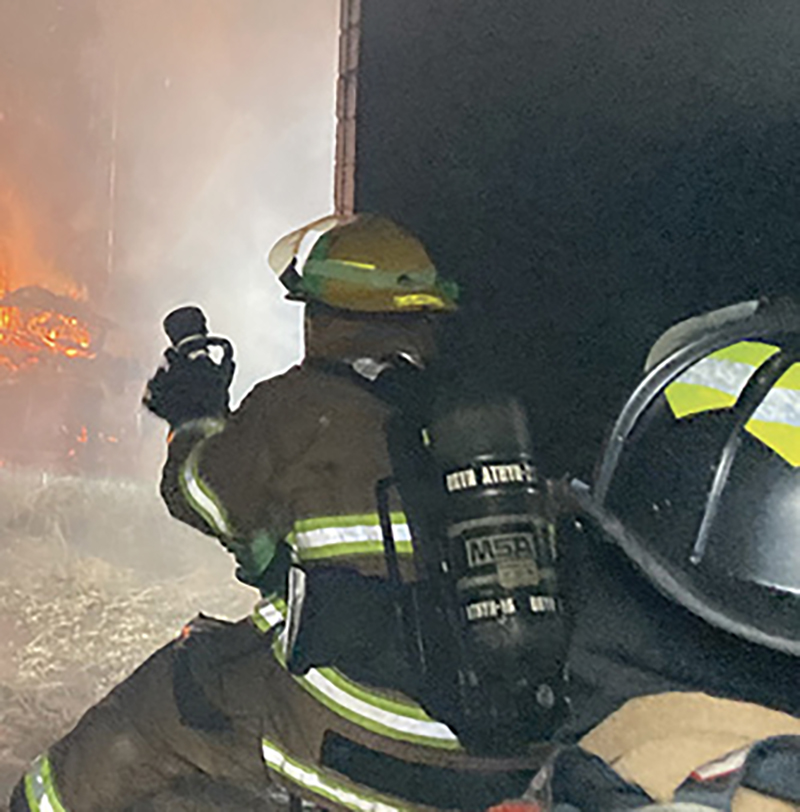
(5) Students in the Interior Firefighter class advance a hoseline in the burn building.
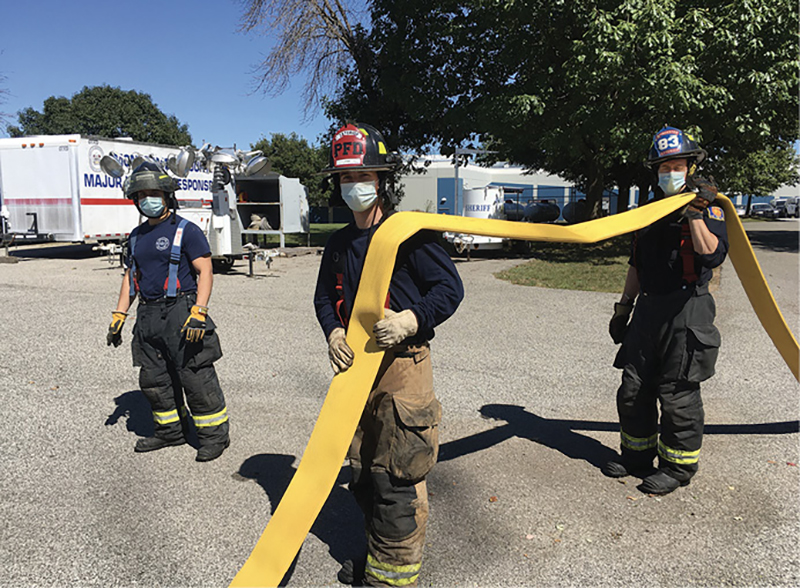
(6) At the end of the Exterior Firefighter class, students take up the hoseline used in the class.
The requirements for hands-on and classroom training were not easy for our students, instructors, and fire academy staff. As they lined up outside the fire academy for temperature scans and symptom screening, students were required to stand six feet apart on the blue dots. Before the weekend lunches, they went through a second temperature scan, and the hot meal was now a boxed lunch. Face masks were required for students, instructors, and staff at all times. These safety requirements continued through the Spring 2021 semester, with the requirement for reduced classroom capacity and temperature scans ending for the Fall 2021 semester. However, masks and social distancing were still required for students and instructors while eating hot lunches in the cafeteria—this remained mandatory until the Spring 2022 semester.
With all these safety requirements, the firefighters, instructors, and fire academy staff never complained. They were a credit to their fire companies and the fire service. Our firefighters, instructors, and fire academy program coordinators set a standard that the other disciplines were unable to meet—and the plan worked. Although several students tested positive for COVID-19, to date, none of the cases traced back to the fire academy.
Lessons Learned
Following are the lessons learned in the planning and implementation of our pandemic training.
Planning and preparation pay dividends. To restart training, we needed a safety plan that would allow us to restart training and testing during the “yellow” phase of the Pennsylvania Return to Work Plan. Our goal was to protect the health and wellness of all personnel, students, instructors, evaluators, and staff involved in training and certification testing. Our COVID-19 safety procedures had to be consistent with the United States Centers for Disease Control and Prevention’s Interim Guidance for Administrators of U.S. Institutions of Higher Education and approved by our chief medical officer.
I never considered a pandemic in my plans for training firefighters. Thankfully, others in the Montgomery County Department of Public Safety had planned for this type of emergency. Our director of public safety and deputy director of the Emergency Management Division provided us with the technology, supplies, and support we needed to restart training during the pandemic.
Synchronous online training filled a training void. Prior to the pandemic, all training was in the classroom at the fire academy or fire stations. With the requirements of our safety plan, our ability to provide training was limited. With synchronous online classes for awareness and refresher classes, enrollment remained limited, but we could train more students than we could in a half-capacity classroom.
Be adaptable. Just like on the fireground, you must be able to adapt your plans. We were required to conduct a second temperature scan on weekends before lunch. So, we set up the scanner and computer at the entrance to the cafeteria and staggered the lunch schedule for the classes. Students stood in line six feet apart on the “Play It Smart, Keep Six Feet Apart” markers on the floor. A staff member monitored the scanning station.
The temperature scans worked fine for the students coming from a temperature-controlled classroom, but when they came inside from ladder or hose training, they were hot and routinely failed the temperature scan. We quickly realized that these students required a cool-down period before a pre-lunch temperature scan.
As the director of the Montgomery County Fire Academy, it was my job is to provide the best training possible to Montgomery County firefighters. Despite the reduced capacity imposed during the pandemic, in 2021, we processed 4,560 enrollments, ran 253 classes for 1,776 students, totaling 42,271 hours of training that included 62 virtual classes for 1,300 students; this is approximately 70% of our pre-pandemic productivity in 2019 and was only possible because of the dedication and arduous work of fire academy and Department of Public Safety staff.
TOM GARRITY is a 36-year veteran of the Philadelphia (PA) Fire Department, serving 17 of those years as deputy chief, and was the director of the Montgomery County (PA) Fire Academy from May 2010 until his retirement in July 2022. He was also the part-time coordinator of the Fire Science and Public Safety Administration Program at Holy Family University and a part-time instructor in the Fire Science Program at the Community College of Philadelphia. Garrity has a graduate degree in public safety administration from St. Joseph’s University and is a graduate of the National Fire Academy’s Executive Fire Officer program.

